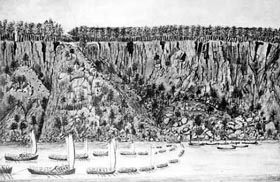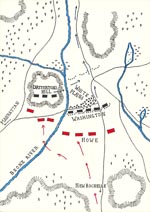Colonial Wars |
American Wars |
Link To This Page — Contact Us —
The Battle of White Plains
October 28, 1776 at White Plains, New York
 |
|||||||||||||
|
British Regiments:
The Second Brigade comprising: 5th, 28th, 35th and 49th Regiments of Foot and the 16th Light Dragoons. Rahl’s Regiment of Hessians and further unidentified Hessian Regiments.
American Formations: Spencer’s Division (New England), Hazlet’s Delaware Regiment, McDougall’s 1st New York, Ritzema’s 3rd New York, Smallwood’s Maryland Regiment, Webb’s Connecticut Regiment, Brook’s New York militia and Graham’s Massachusetts militia.
After the Battle of Long Island, the British army, commanded by Lt. Gen. William Howe, forced the American army, commanded by Gen. George Washington, off of Manhatten Island. Howe pursued Washington slowly out of New York City into the countryside. Howe extended his own command in a line running from New Rochelle in the south to the village of Scarsdale in the north. Howe and his Tory sympathizers had a stronghold in New York City.
After Washington abandoned Manhatten Island, deployed his force in a lengthy defensive line in Westchester County, with the northern part at White Plains. White Plains was located 20 miles northeast of New York City. It was a rural and sparsely populated farming community. The terrain consisted of gently rolling hills through which ran the Bronx River Valley. His objective was to escape the encircling grasp of the British while evacuating tons of supplies before they could be captured by the superior British force.
At the urging of the Continental Congress, Washington had to leave some 2,800 troops, commanded by Col. Robert Magaw, to occupy Fort Washington and another 3,500 troops under Maj. Gen. nathanael Greene to defend the opposite shore at Fort Lee. Their mission was to disrupt and prevent the British fleet from moving upriver above the forts and into the Hudson River Valley.
On October 22, Washington and his army arrived at White Plains. They joined their advance unit, which started arriving the day before, and began fortifying the three surrounding hills. At White Plains, Washington deployed his army along a width of 3 miles, including passing through the town. The right flank was commanded by Brig. Gen. William Heth, the center was commanded by Washington, and the right flank was commanded by Brig. Gen. Israel Putnam. Howe was at New Rochelle, were he was not in any hurry to move against Washington. This gave the Americans time to arrive safely at their new position.

On October 23, about 8,000 Heissens, commanded by Lt. Gen. Wilhelm von Knyphausen, arrived at New Rochelle and reinforced Howe's army. Howe decided to leave some 4,000 Hessians to garrison New Rochelle.
On October 27, the British advance guard arrived at White Plains. Chatterson's Hill rose 180 feet above the plain and the top was gently rounded with the hillsides being wooded and steep. The hilltop was divided into cultivated fields by stone walls. It was located to the right of the American line, across the Bronx River. At the time, Washington had not fortified this position.
Washington's conclave double-line front covered the town of White Plains. Facing south, the American line was anchored on the right flank (west) on Purdy Hill along the Bronx River and on the left beyond the town on Hatfield Hill near a large pond. The center was directly in front of the town. Beyond Washington's right, about 1/2 mile on the far side of the river, was Chatterson's Hill. Initially, Washington did not percieve the hill as important enough to occupy.
On October 28, in the morning, the British entered Scarsdale and advanced towards White Plains. Howe received intelligence that Washington had concentrated his army and deployed it in a large shallow crescent below the village, with the narrow swollen Bronx River protecting the American right flank. Howe's advance was formed into two columns, one British and the other Hessian. Lt. Gen. henry Clinton commanded the British column and Maj. Gen. Wilhelm von Heister commanded the Hessians. Washington ordered Brig. Gen. Joseph Spencer to take 1,500-man detachment and two cannons to block the British in the plains between Chatterson's Hill and Scarsdale. Spencer had the front line manned by the Massachusetts militia and the second line was manned by the Delaware Continentals.
At 9:30 A.M., once the delaying force made contact with the British, they returned and informed Washington that they were approaching in two columns along the East Chester Road. Once at White Plains, Howe deployed his army in an open area about 1 mile in front of the American line. Howe spotted Chatterson's Hill and recognized that it as critical terrain. He planned the main attack against Chatterson's Hill while the rest of his army kept the rest of the American line occupied.
At Chatterson's Hill, Howe started out with an artillery bombardment, then sent a 4,000-man detachment to attack the American position. First, he sent 3 Hessian regiments, commanded by Col. Johann Rall, across the river, where they took up positions at some ridges about 1/2 mile from Chatterson's Hill. Next, the rest of the attacking force crossed a ford downstream, the made their way up the hill. Finally, the 17th Dragoons were sent on a cavalry charge, the first cavalry charge of the war. (*Rall would be mortally wounded two months later while commanding the Hessians at the Battle of Trenton.*)
Rall threatened Spencer's left flank. The militia paniced and was soon routed but the Continentals put up a stiff resistance before being forced to make an orderly withdrawal. The Americans were driven back across the river onto Chatterson's Hill. With the British now in close proximity, Washington suddenly realized the critical nature of Chatterson's Hill and decided to strengthen it. He ordered about 1,600 troops, comprised of Delaware Continentals and Maryland militia to assist in occupying the hill. This brought the hill's total defensive force to around 2,500 troops. Maj. Gen. Alexander McDougall assumed command of the hill's force.
After Spencer's detachment was driven away, Howe moved his army into the flat land below the high ground and in front of the town in clear view of Washington. Howe then broke apart his command, sending 8 regiments to attack the high ground of Chatterson's Hill. He also positioned 20 cannons below Chatterson's Hill and opened fire on the American positions. McDougall was only able to fire a couple of shots before he was forced to abandon his cannons.
As the British artillery barrage continued, British and Hessian troops made their way under fire to the Bronx River. They then crossed the river and deployed to attack the hill.
The British regiments attacked directly against the American positions while the Hessians attempted a flanking manuever against the American right flank. The British were forced back with heavy casualties but the Hessians took up a position beyond the American left flank, which was held by inexperienced New York and Massachusetts militiamen. The fight lasted only a few minutes before the militia fled. The fleeing militia exposed the flank of the Delaware troops. The appearance of the advancing Hessians threw the Delaware troops into confusion.
Although many companies formed and repulsed several Hessian attacks, pressure against their front continued and the supporting troops were breaking for the rear. Unable to sustain a defense, the remainder of the Delaware troops were forced to make an orderly withdrawal from the field. After the loss of Chatterson's Hill, Washington had little choice but to withdraw farther north, beyond the Croton River, to Castle Hill.
At 5:00 P.M., the battle ended. Howe was content to hold onto Chatterson's Hill. Two days later, Howe made plans for a general assault against Washington's army. Heavy rains and winds hampered any further manuevers for both commanders.
On November 1, the British advanced but found out that Washington and his army was gone, having withdrawn into the hills north of White Plains. Howe decided not to follow the Americans and allowed them to safely retreat into New Jersey.
On November 4, Howe withdrew his army from White Plains and returned to New York City. Because Washington still had the majority of his army with him, he would soon claim two important victories at the Battle of Trenton and the Battle of Princeton.
